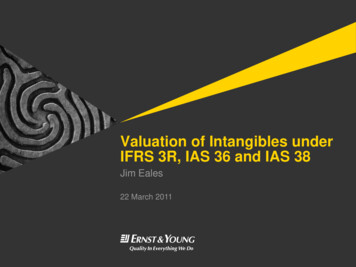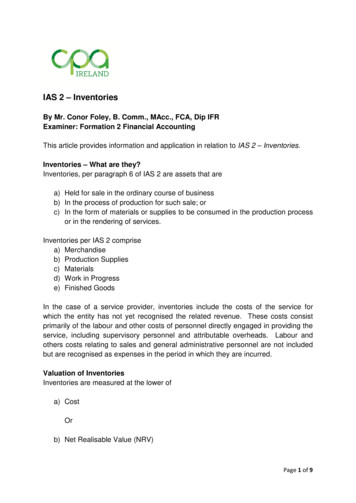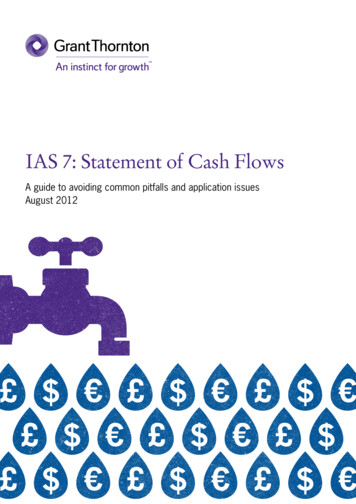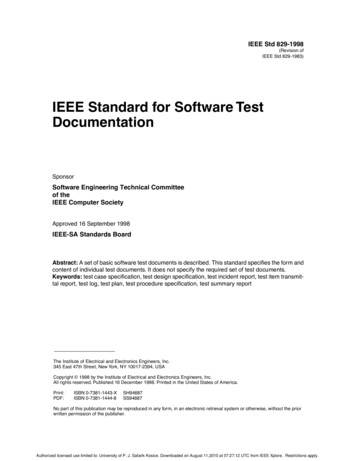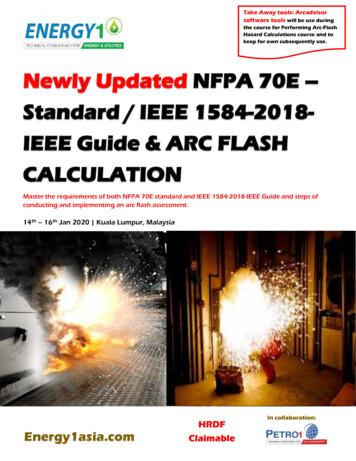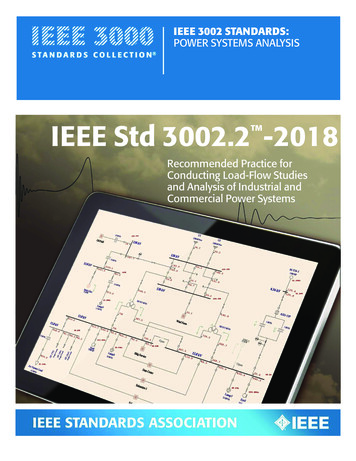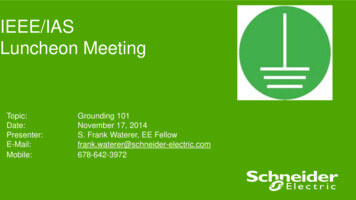
Transcription
IEEE/IASLuncheon g 101November 17, 2014S. Frank Waterer, EE 3972
IEEE/IAS 17 Nov 20142
Applicable Codes and Standards Pertaining to Bondingand Grounding Systems (General) IEEE Standard 142 -2007, “IEEE Recommended Practice for Grounding ofIndustrial and Commercial Power Systems”, IEEE Standard 80 - 2000 “IEEE Guide for Safety in AC SubstationGrounding” IEEE Standard 81 -1983 “IEEE Guide for Measuring Earth Resistivity,Ground Impedance, and Earth Surface Potentials of a Ground System”, IEEE Standard 1100 -2005 – “IEEE Recommended Practice for Poweringand Grounding Electronic Equipment”, IEEE Standard 446 -1995 “IEEE Recommended Practice for Emergencyand Standby Power Systems for Industrial and Commercial Applications”(Chapter 7).IEEE/IAS 17 Nov 20143
Applicable Codes and Standards Pertaining to Bondingand Grounding Systems (General) NFPA 70, 2014 Edition - National Electrical Code (NEC ) [Articles250, 690, & 702] IEEE Standard 2012 - National Electrical Safety Code (NESC) NFPA 780, 2011 Edition – Standard for the Installation of LightningProtection System UL 96A – Installation Requirements for Lightning Protection Systems UL 467 – Bonding and Grounding EquipmentIEEE/IAS 17 Nov 20144
Applicable Codes and Standards Pertaining to Bondingand Grounding Systems (General) IEEE Standard 837 - 2002, “IEEE Standard for Qualifying PermanentConnections Used in Substation Grounding” 3003.1 – 2014, “Recommended Practice for the System Grounding ofIndustrial and Commercial Power Systems”(Drafted to replace IEEE Standard 142 -2007) 3003.2 – 2014, “IEEE Draft Recommended Practice for EquipmentGrounding and Bonding in Industrial and Commercial Power Systems”(Drafted to replace IEEE Standard 142 -2007)IEEE/IAS 17 Nov 20145
Applicable Codes and Standards Pertaining To Bonding andGrounding Systems in Healthcare Facilities NFPA 70 , (NEC Article 250 & NEC Article 517) NFPA 99 , (Chapter 6 and Chapter 10) IEEE Standard 80 (IEEE Guide for Safety in AC Substation Grounding) IEEE Standard 81 (IEEE Guide for Measuring Earth Resistivity, Ground Impedance, and earthSurface Potentials of a Ground System) IEEE Standard 142 (IEEE Recommended Practices for Grounding of Industrial and CommercialPower Systems) IEEE Standard 446, Chapter 7 (IEEE Recommended Practice for Emergency and Standby PowerSystems for Industrial and Commercial Applications) IEEE Standard 601, Clause 3.6 and Chapter 6 (IEEE Recommended Practice for ElectricalSystems in Healthcare Facilities) IEEE StandardEquipment)IEEE/IAS 17 Nov 20141100 (IEEE Recommended Practice for Powering and Grounding Electronic6
Applicable Codes and Standards Pertaining to the Testing of Bonding and Grounding Systems NEC Article 250 (Contrary to popular belief, there are no testing or maintenance requirementsin Article 250.) NFPA 99 - 2012, Chapter 6, – Electrical System Requirements (Paragraph 6.3.3– “PerformanceCriteria and Testing”) NFPA 99 - 2012, Chapter 10 – Electrical Equipment (Paragraph 10.3 – “Testing Requirement – Fixedand Portable”) [The 2012 Edition has more focus on “Leakage Currents” and “Touch Currents”] IEEE Standard 81 (IEEE Guide for Measuring Earth Resistivity, Ground Impedance, and earthSurface Potentials of a Ground System) IEEE Standard 142, Chapter 4 (IEEE Recommended Practices for Grounding of Industrial andCommercial Power Systems) IEEE Standard 601, Clause 6.8.6.e – Field inspection procedure (This clause recommends testing,but does not mandate testing or provided for specific testing methods.) NFPA 70B - 2010, Chapter 11, – Grounding Systems(Very brief general information provided ontesting of “grounded conductor’ and ‘grounding electrode’.) If a bonding or grounding system is not routinely inspected or tested, how do you know if it isadequate or effective for the needs of the specific facility or installation?IEEE/IAS 17 Nov 20147
Applicable American Codes and Standards Pertaining to Bonding and GroundingSystems as it Relates to Lightning Protection NFPA 70, 2014 Edition - National Electrical Code (NEC ) [Articles 250, 285,500, 502, 505, 694, 800] IEEE Standard 2012 - National Electrical Safety Code (NESC) NFPA 77 – Recommended Practice on Static Electricity NFPA 780 – Standard for the Installation of Lightning Protection System UL 96A – Installation Requirements for Lightning Protection Systems API RP [American Petroleum Institute (Recommended Practice)] -ProtectionAgainst Ignitions Arising Out of Static Lightning and Stray Currents UL 467 – Bonding and Grounding Equipment IEEE Std. 998 - IEEE Guide for Direct Lightning Stoke Shielding of Substations DoD, DoE, NASA, and FAA Lightning Protection RequirementsIEEE/IAS 17 Nov 20148
Applicable European Codes and Standards Pertaining to Bonding and GroundingSystems and Lightning Protection IEC Standard 10234-1 IEC Standard 61364-S IEC Standard 62305 ENV 61024-1IEEE/IAS 17 Nov 20149
Applicable British Codes and Standards Pertaining to Bonding and GroundingSystems and Lightning Protection BS 1400 BS 6651 BS 7430IEEE/IAS 17 Nov 201410
Applicable Canadian and Australian Codes and Standards Pertaining to Bonding andGrounding Systems and Lightning Protection CSA C22.12 (2012) (aka; The Canadian Electrical Code) AS1768 AS2307 AS3000IEEE/IAS 17 Nov 201411
Contrary to popular illusions and misconceptions, ‘GOLFERS’ are nothingmore than ‘ambulatory or portable lightning abatement systems’!IEEE/IAS 17 Nov 201412
Differences Between Bonding and Grounding Is a green vinyl covered copper conductor (some times greenvinyl with yellow stripe) located within a power circuit conduitalong with the three ‘phase’ conductorsa.)a “grounding conductor”,b.)a “ground wire”,c.)a “bonding conductor” Exactly what is the intended purpose of the typical green vinylcovered copper conductor located within a power circuitconduit?IEEE/IAS 17 Nov 201413
Differences Between Bonding and Grounding Is a green vinyl covered copper conductor (some times green vinyl with yellowstripe) located within a power circuit conduit along with the three ‘phase’conductorsa.)a “grounding conductor”,b.)a “ground wire”,c.)a “bonding conductor”Exactly what is the intended purpose of the typical green vinyl covered copperconductor located within a power circuit conduit? Toprovide for anequipment bond to effective maintain an equal-potentialbetween all metallic parts and equipment and to provide for aneffective ground fault return path between the point of the faultand the source of electrical power.IEEE/IAS 17 Nov 201414
Which conductor is the “Grounding Conductor” in this 3 phase feedercircuit?IEEE/IAS 17 Nov 201415
This ‘feeder circuit’ consist of 3 phase conductors 1 neutralconductor. There is NO actual “Grounding Conductor” associated withthis 3 phase feeder circuit.IEEE/IAS 17 Nov 201416
Differences Between Bonding and Grounding The terms “bonding” and “grounding” are often employedinterchangeably as general terms in the electrical industry toimply or mean that a specific piece of electrical equipment,structure, or enclosure is somehow referenced to earth. In fact, “bonding” and “grounding” have completely differentmeaning andemploy IAS 17 Nov 201417
Bonding“Bonding” is a method by which all electrically conductive materials and metallicsurfaces of equipment and structures, not normally intended to be energized, areeffectively interconnected together via a low impedance conductive means and path inorder to avoid any appreciable potential difference between any separate points.The bonded interconnections of any specific electrically conductive materials, metallicsurfaces. The bonding of any metallic enclosures, electrical equipment, pipes, tubes,or structures via a low impedance path is completely independent and unrelated toany intended contact or connection to the Planet Earth.For example, airplanes do not have any connection to the planet Earth when they areairborne. It is extremely important for the safety and welfare of passengers, crew, andaircraft the all metallic parts and structures of an airplane are effectively bondedtogether to avoid difference of potential between structures and parts when travelingat high rates of speed or when the frame of the aircraft is struck by lightning.IEEE/IAS 17 Nov 2014.18
BondingThe laboratories and satellites orbiting in space above the planet Earthobviously have no direct connection with the surface of our planet.However, all of the conductive surfaces of these orbiting laboratories andsatellites must be effectively bonded together in order to avoid differences ofpotential from being induced across their surfaces from the countlesscharged particles, magnetic energy fields, and solar produced magneticwaves traveling through space.IEEE/IAS 17 Nov 201419
BondingThe common means to effectively bond different metallic surfaces ofenclosures, electrical equipment, pipes, tubes or structures together are withcopper conductors, rated lugs, and the appropriate bolts, fasteners, orscrews. Other effectively bonding means between different metallic parts and piecesmight employ brackets, clamps, exothermic bonds, or welds to make aneffectively connections. In addition to preventing potential differences that may result in hazards,effectively bonded equipment can also be employed to adequately andsafely conduct phase-to-ground fault current, induced currents, surgecurrents, lightning currents, or transient currents during such abnormalconditions. .IEEE/IAS 17 Nov 201420
Is the connected load equipment “effectively bonded” to the supplying system?IEEE/IAS 17 Nov 201421
Are these two pieces of equipment “effectively bonded”together?IEEE/IAS 17 Nov 201422
Are these two pieces of Equipment “effectively bonded”together?IEEE/IAS 17 Nov 201423
Grounding “Grounding” is a term used rather exclusively in North American to indicate a director indirect connection to the planet Earth or to some conducting body that serves inplace of the Earth. The connections to Earth can be intentional or unintentional by an assortment ofmetallic means intended to be employed as a designated grounding electrode. A designated “grounding electrode” is the device that is intended to establish thedirect electrical connection to the earth. A common designated grounding electrode is often a copper clad (0.008”) or copperflashed (0.004”) coated steel rod. The designated “grounding electrode” might also be a copper or black iron water pipe,steel columns of a building or structure, concrete encased steel reinforcement rods,buried copper bus, buried copper tubing, galvanized coated steel rods or plates, orsemi conductive neoprene rubber blankets. Gas pipes and aluminum rods can notbe employed as grounding electrode. FOR UNDERSTANDABLE REASONS! The grounding electrode conductor is the designed conductor that is employed toconnect the designated grounding electrode to other equipment groundingconductors, grounded conductor, and structures.IEEE/IAS 17 Nov 201424
Earthing or Earthed “Earthing” and “Earthed” is a term developed by the UnitedKingdom and part of the British Electrical Code and is employed inEurope or other countries that employs International ElectricCommission (IEC) standards. The term “earthing” in European or IEC countries is synonymouswith the term “grounding” in North America. The term “earthed” in European or IEC countries is synonymous with theterm “grounded” in North AmericaIEEE/IAS 17 Nov 201425
This tank was determined to be ‘effectively bonded andgrounded. However, one might be amazed at what iscommonly mixed into popular beers.IEEE/IAS 17 Nov 201426
Is this electrical service “effectively grounded” or“Earthed”?IEEE/IAS 17 Nov 201427
The Five Principal Purposes of Bonding & Grounding SystemsThe principle purposes for an “effectively bonded grounding system via a low impedancepath to earth” are intended to provide for the following.1. Provide for an applicable reference to earth to stabilize the system voltage of a powerdistribution system during normal operations.2. Create a very low impedance path for ground fault current to flow in a relatively controlledpath.3. Create a very low impedance path for ground fault current to flow in order for overcurrentprotective devices and any ground fault protection systems to operate effectively asdesigned and intended.4. Limit differences of potential, potential rise, or step gradients between equipment andpersonnel, personnel and earth, equipment and earth, or equipment to equipment.5. Limit voltage rise or potential differences imposed on a power distribution system fromlightning, a surge event, any phase-to-ground fault conditions, or the inadvertentcommingling of or the unintentional contact with different voltage system.IEEE/IAS 17 Nov 201428
Principal Purposes of Bonding and Grounding SystemsThe principal purposes for an “effectively bonded grounding system via a lowimpedance path to earth” are intended to provide for the following. 1. Provide for an applicable reference to earth to stabilize the system voltage ofa power distribution system during normal operations.The system voltage is determine by how the secondary winding of any power class ordistribution class transformer is actually configured as well as how the windings arereferenced to ground or earth.The primary function or purpose of the system bonding jumper is to provide for anapplicable reference to earth for the system voltage at the origins of the specific andseparately derived system to stabilize the voltage. (i.e., 600Y/347V, 480Y/277V, or208Y/120V, 3 Phase, 4 Wire, Solidly Grounded, “WYE” Systems)The system bonding jumper is employed as a direct connection between the Xoterminal of a supplying transformer, generator, or
17.11.2014 · IEEE Standard 142, Chapter 4 (IEEE Recommended Practices for Grounding of Industrial and Commercial Power Systems) IEEE Standard 601, Clause 6.8.6.e –Field inspection procedure (This clause recommends testing, but does not mandate testing or provided for specific testing methods.)
